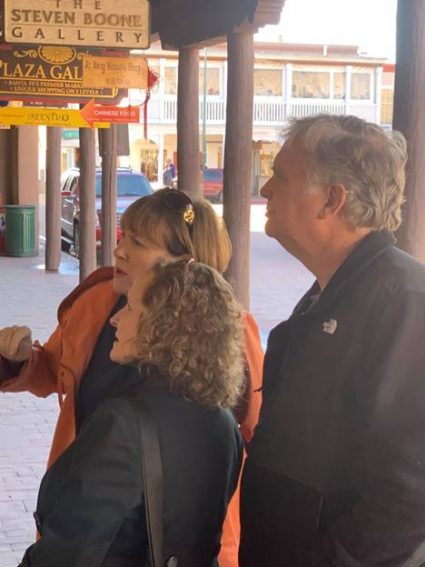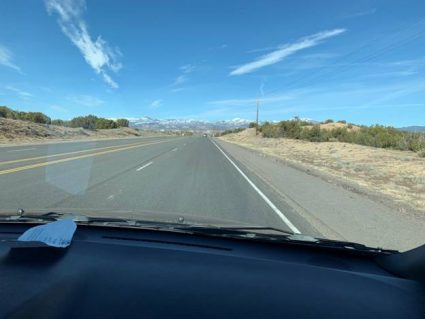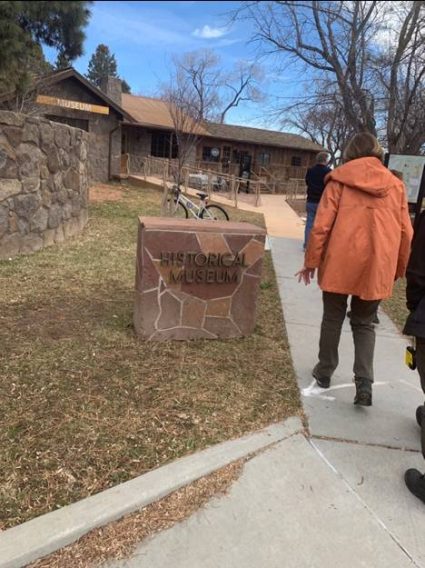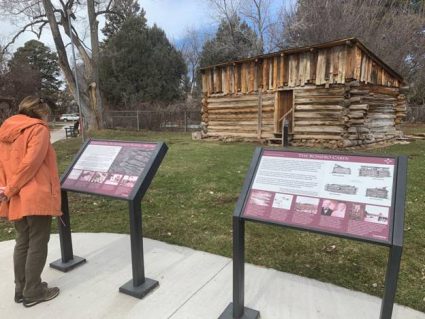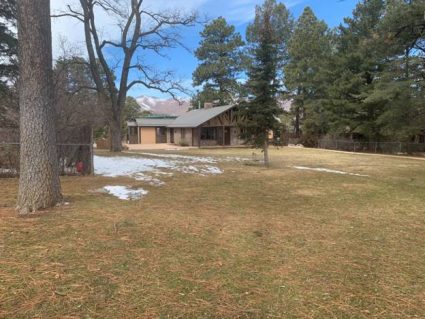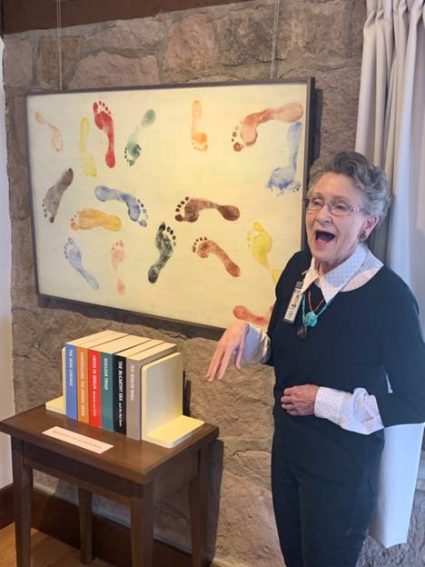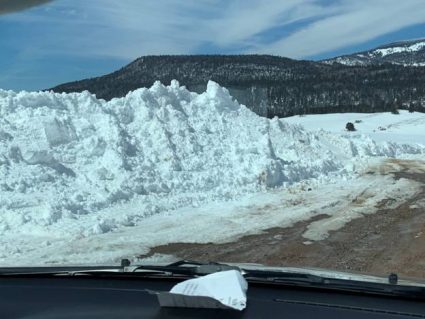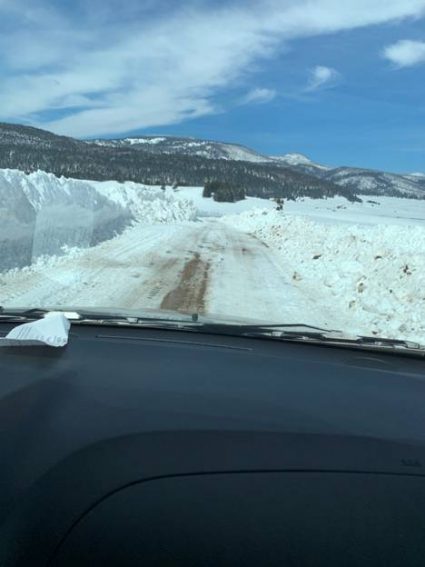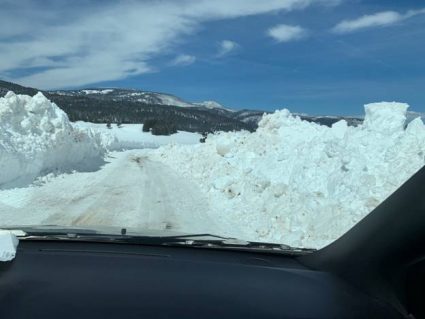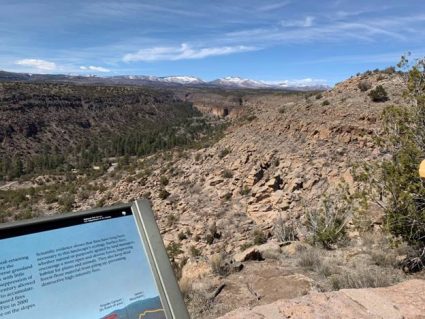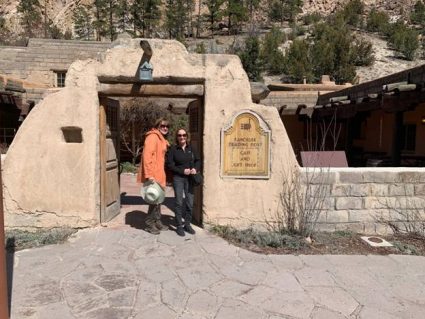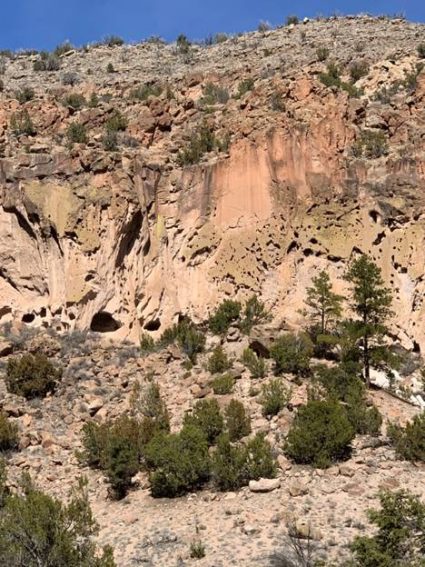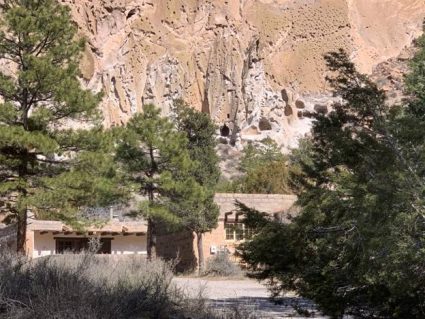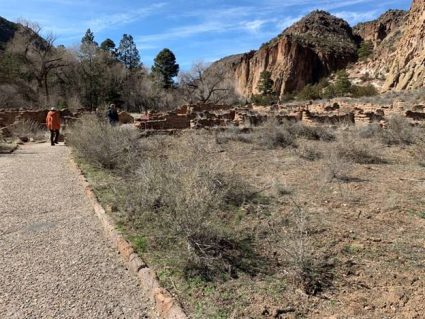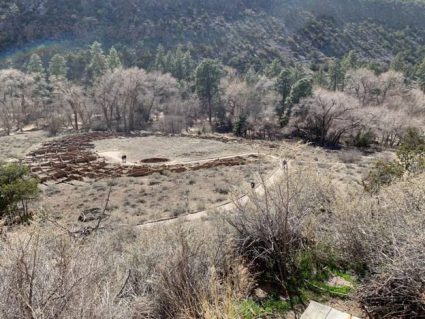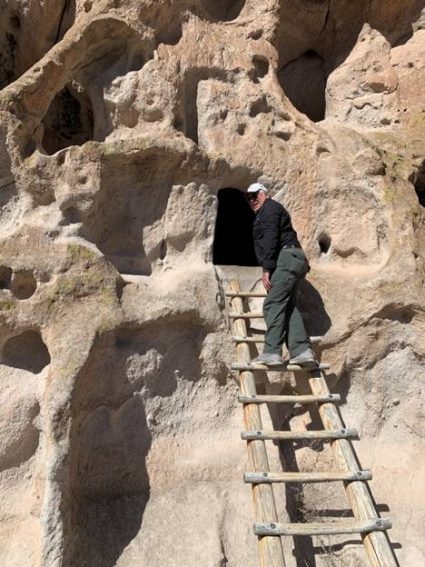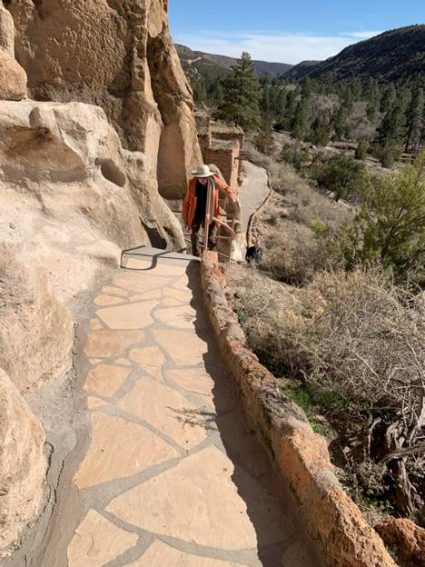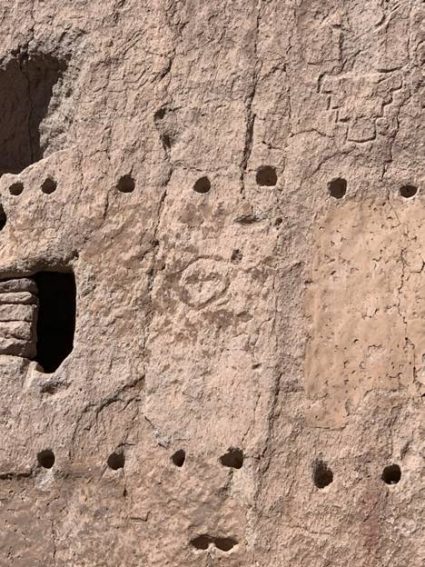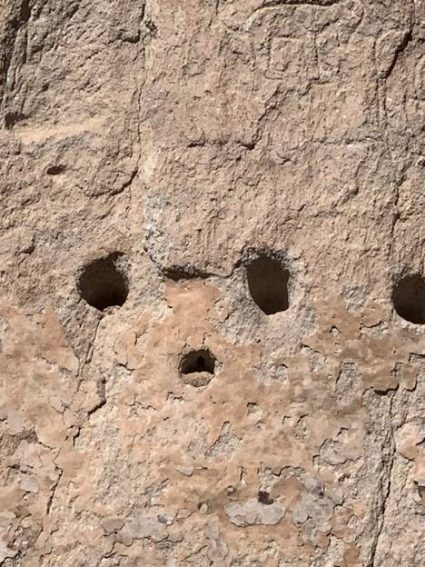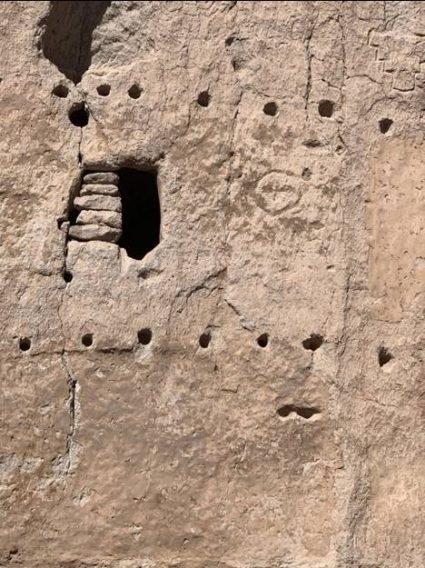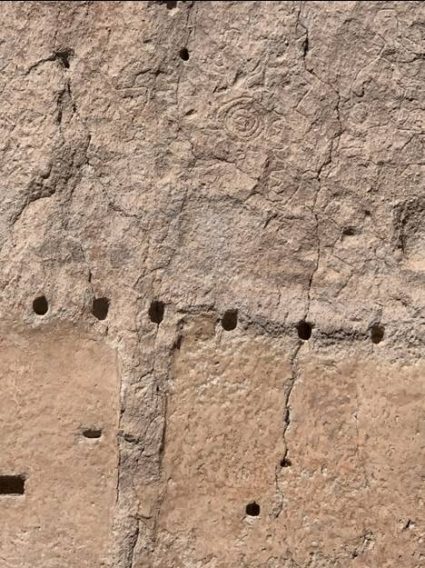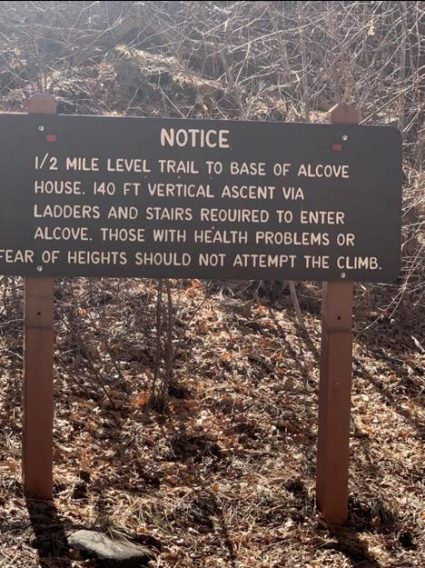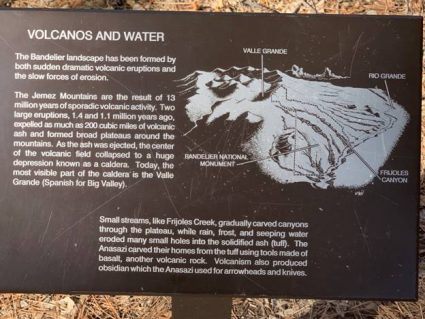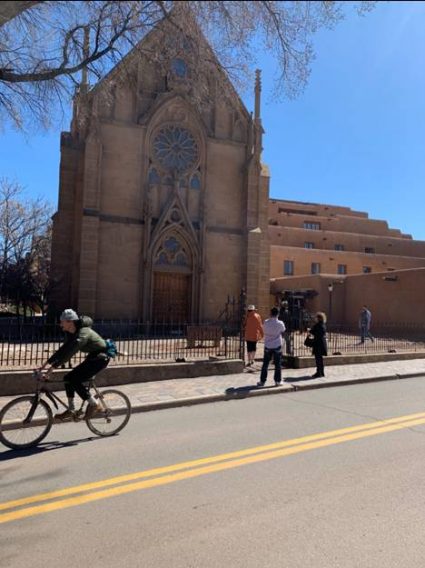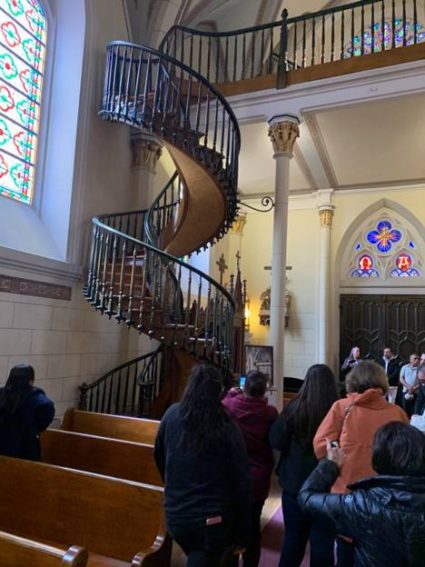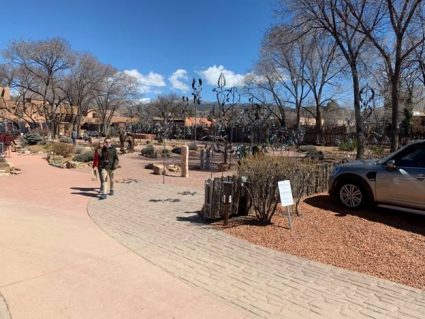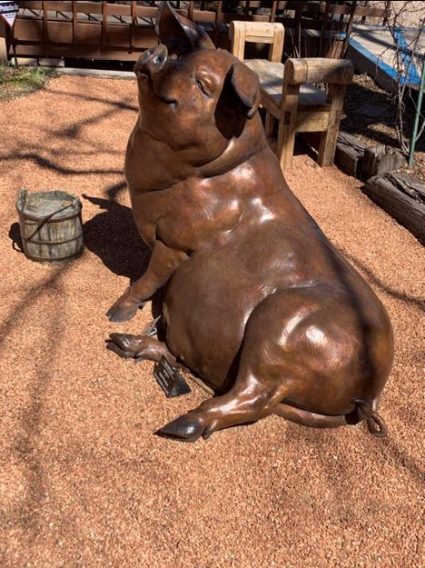St. Patrick’s Day in Santa Fe
March 15, 2019
It has become something of a tradition for my wife and me to join our friends, Jerry and Rosie Johnson for a long St. Patrick’s Day weekend travel adventure. This year we visited Santa Fe, New Mexico. This added a new state to my travels as I have never visited New Mexico before.
On Friday, both couples flew to Albuquerque, then rented a car and drove to Santa Fe. The weather was cool and we had just missed considerable snow that had grounded flights out of Santa Fe earlier in the week. But, by the time we arrived, most of the snow had melted.
It was about a two hour drive from Albuquerque to Santa Fe.
While Albuquerque sits about 5,000 feet above sea level, Santa Fe is 7,200 feet. The first day we were all panting a bit from the thin air at that altitude.
The city of Santa Fe was founded by Spanish colonists in 1610, making it one of, if not the oldest cities in the United States. Prior to its founding, the area was occupied for at least several thousand years by indigenous peoples who built villages on the current site of the city.
The phrase “Santa Fe” is translated as “Holy Faith” in Spanish. Although more commonly known as Santa Fe, the city’s full, legal name remains to this day as La Villa Real de la Santa Fe de San Francisco de Asís.
Our first afternoon we just walked around the downtown area to get a little bit familiar.
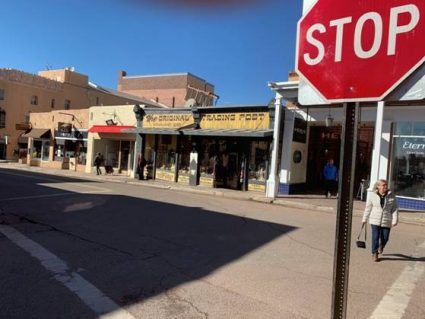
Much of the downtown has been preserved or restored to its origins.
It was not unusual to see people entertaining in hopes for a few bucks.
Jerry, Rosie and Pat are admiring some jewelry in the window.
A lot of time and money went into fixing up this pickup.
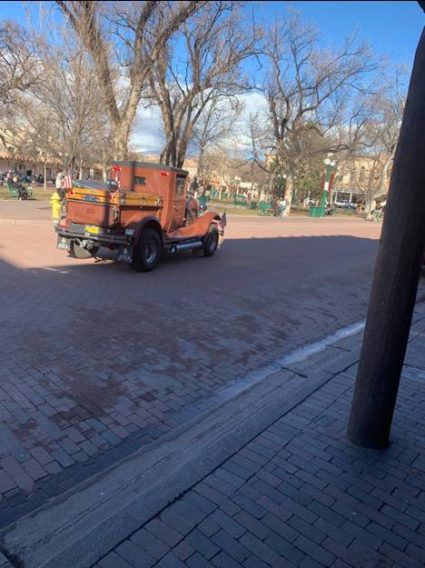
We were all pretty exhausted from our travels, the altitude and the time-zone change. We ate a fairly early dinner and returned to our respective quarters for the night.
March 16, 2019
After breakfast, Pat found that she could get in her morning swim at the Johnson’s hotel.
LOS ALAMOS
We next decided to visit Los Alamos where the Manhattan Project was headquartered during World War II.
Los Alamos is only about 30 minutes outside Santa Fe. The drive to there was beautiful at 7,200 feet elevation with snow-capped mountains in the background.
While famous for the Manhattan Project to develop the nuclear bombs that helped bring an end to World War II, Los Alamos today is one of the largest science and technology institutions in the world. It conducts multidisciplinary research in fields such as national security, space exploration, nuclear fusion, renewable energy, medicine, nanotechnology and supercomputing.
We started our visit at the Museum which used to be the guest cottage. Many buildings have been maintained and restored from the originals.
The whole facility at Los Alamos used to be the home of the Los Alamos Ranch School which was a boarding school for boys that combined an excellent education with outdoor living.
In 1918, entrepreneur Ashley Pond began an “outdoor school” at Los Alamos to provide boys a chance to gain health, strength and self-confidence. The Los Alamos Ranch School combined a rigorous outdoor experience with a college preparatory education.
The Los Alamos Ranch School comprised 54 buildings: 27 houses, dormitories, and living quarters totaling 46,626 sq. ft., and 27 miscellaneous buildings: a public school, an arts & crafts building, a carpentry shop, a small sawmill, barns, garages, sheds, and an ice house totaling 29,560 sq. ft. There were also 4 houses, with approximately 20 rooms, and a small barn at the Anchor Ranch site.
Representatives from the Manhattan District, the Albuquerque District, and the Southwestern Division Real Estate Branch met in November 1942 at the Los Alamos Ranch School to consider that location in detail. The choice of the site was also discussed with Dr. J. Robert Oppenheimer, Project Director, and members of his staff, for further confirmation of its desirability.
In November 1942, the school and the surrounding land were purchased by the United States Army’s Manhattan Engineering District for use in the top-secret effort to develop the first atomic bomb. The school awarded its final diplomas in January 1943 and the Army took control of the property the following month.
The site was chosen by Lieutenant Genera Leslie Groves for the Manhattan Project because of its isolation, access to water, ample space, pre-existing buildings which could be used for housing and the fact that much of the surrounding land was already owned by the federal government. It was also located on a mesa in which all entrances could be secured. The facility originally was referred to as “Site Y”, but later became known as Los Alamos Scientific Laboratory, then Los Alamos National Laboratory. During World War II, the school’s Fuller Lodge and the Big House were used as social gathering places for Los Alamos project personnel and some other buildings were used for housing. The school buildings were known as “Bathtub Row” because they were the only houses in Los Alamos with bathtubs.
The guest house is the site of the Los Alamos Historical Museum and has an extensive display on the school and its use of Scouting. The adjacent Fuller Lodge is open for visitor viewing and is frequently used for meetings or weddings. The Los Alamos Art Center is housed in the south wing by Central Avenue.
Next was the Romero Cabin.
The Romero family consisted of Victor and Refugio Romero and their six children. Victor filed homestead entry papers in 1916, in which he stated that his house was built in June 1913 and that it had one room and two windows.
He also said that he had a corral and that the claim was fenced on three sides. The Romero family was typically absent from the land during December through March. In those winter months the family lived in the valley at San Ildefonso.
The cabin was rebuilt in 1934 with a major transformation from a v-pitch to a shed style roof. The cabin’s interior was roughly furnished with a homemade table, benches, and shelving. Pot and pans were hung on the walls and the stove was located in the northwest corner of the cabin. A small garden for family use was located behind (to the north of) the house.
A short walk further brought us to the Hans Bethe House which now displays some of the living conditions while the bomb was being developed.
The Hans Bethe House is now the Harold Agnew Cold War Gallery of the Los Alamos History Museum. Formerly called Master Cottage Number One, it was the first residence built by the Los Alamos Ranch School. The director of the school, A. J. Connell, lived there briefly before it became home for the school’s masters.
The quaint cottage is named for Harold Agnew who flew as a scientific observer on the Great Artiste, a plane accompanying the Enola Gay on its bombing run over Hiroshima. It has been home to eminent scientists. During the Manhattan Project, Edwin and Elsie McMillan moved into the house with their young daughter, Ann. When they moved out, Hans and Rose Bethe moved in. Both Edwin and Hans would go on to win Nobel Prizes for their scientific contributions.
Our guide was an absolutely charming woman who was very excited to tell us stories from the past.
Harold Agnew was a printer and used to print Christmas cards with his own equipment. One night in the early 1950’s, the Agnews had a cocktail party that included several Los Alamos luminaries. The guests were asked to remove their shoes, paint a foot with ink and hard rubber rollers and step on this piece of Masonite. Many of the guests signed their names to their footprints.
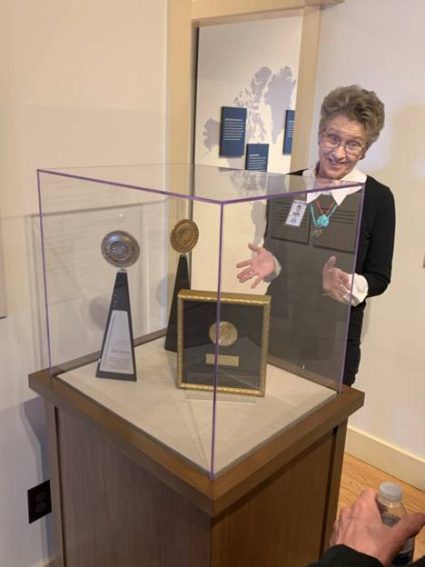
Here our guide shows the display of the actual Nobel Prize medal given to Frederick Reins for his work at Los Alamos.
We drove around a little bit to get a sense of the size of Los Alamos and the Manhattan Project.
VALLES CALDERA
We then headed further up to Valles Caldera, a huge dormant volcanic crater.
There had been considerable snow in the area during the week prior to our arrival and this caldera was high enough that the snow hadn’t melted. Only one lane had been plowed to get to the visitors center.
The Caldera is the collapsed cone of the Jemez Volcano, one of only three super volcanoes in North America. Two massive eruptions over a million years ago (each more than 600 times more powerful than the Mount St. Helens eruption in 1980) deposited ash hundreds of feet thick. The caldera is over 14 miles across.
Even with the heavy snow, it was just amazing to be driving down into this enormous caldera. In the center is a small ranger station and other visitors had brought cross-country skis and were registering for a hike.
BANDELIER NATIONAL MONUMENT
As we drove out of the caldera we drove a few miles to enter the Bandelier National Monument. The Frijoles Canyon was carved over thousands of years by the waters of Frijoles Creek whose headwaters start at the Valles Caldera.
The waters from this canyon flow to the Rio Grande. The floor of this canyon was home to Native Americans for thousands of years – from Ice Age hunters 10,000 years ago to the first pueblo dwellers who arrived about 800 years ago.
From here we drove to the bottom of the canyon to a small outpost where we had lunch before taking a hike.
The café was running low on supplies so lunch took longer than we expected. We did, however, enjoy really good hamburgers.
Then we set out to hike the trails through the canyon.
Compacted volcanic ash is called ‘Tuff’ and that is what this canyon is carved from. The Pueblo people were able to carve the Tuff into building blocks or carve out the side of the canyon walls to create living space.
Some carved out caves we saw from a distance:
Then we passed the remains of much larger building created from the carved blocks of Tuff.
A view from above.
Then some real effort was required to climb the sides of the canyon walls to see the carved-out living spaces.
While paved paths and steps were provided along the way, the climb was still very steep and strenuous.
Along the way you could see where the Pueblos had bored holes in the canyon walls to insert support for walk ways. Above the walk ways they had carved glyphs.
We descended from the cliff dwellers habitat and continued our walk along the floor of the canyon and back toward the café.
Along the way we were afforded the ‘opportunity’ to take a small diversion to the Alcove House.
None in our group expressed interest in making the required climb.
The sign below was helpful in understanding the geology of our visit to this area.
This completed our trip to the National Monument and we drove back to Santa Fe.
Dinner that night was at La Plazuela at La Fonda and was delicious.
March 17, 2019
This was our day to take a walking tour of downtown Santa Fe.
We started at the Loretto Chapel.
The Chapel and its location are important to the history of Santa Fe. On August 18, 1846, Brigadier General Stephen Watts Kearny led his Army of the West down the Santa Fe Trail past these premises to the plaza where he took possession of New Mexico for the United States. Four Sisters of Loretto arrived over the Trail with Bishop John B. Lamy on September 26, 1852 to begin their mission of educating young women. The Bishop moved them into his large, two-story ‘Casa Americana’ (located immediately south of the present chapel), on land which with its garden and orchards, ran south to the river and east to present Cathedral Place. In 1902 the Sisters donated the land along the river to the city for Sparks Street, now Alameda.
The old adobe stables and chicken houses (directly east along the street) were converted into the St. Francis Opportunity School for handicapped children in 1939. Now used as shops, these and the chapel are the only buildings remaining from the historic Academy of Our Lady of Light of the Sisters of Loretto at the Foot of the Cross.
This chapel has a staircase that is not only beautiful but somewhat mysterious.
Three mysteries surround the spiral staircase in the Loretto Chapel: the identity of its builder, the type of wood used, and the physics of its construction.
When the Loretto Chapel was completed in 1878, there was no way to access the choir loft twenty-two feet above. Carpenters were called in to address the problem, but they all concluded access to the loft would have to be via ladder as a staircase would interfere with the interior space of the small Chapel.
Legend says that to find a solution to the seating problem, the Sisters of the Chapel made a novena to St. Joseph, the patron saint of carpenters. On the ninth and final day of prayer, a man appeared at the Chapel with a donkey and a toolbox looking for work. Months later, the elegant circular staircase was completed, and the carpenter disappeared without pay or thanks. After searching for the man (an ad even ran in the local newspaper) and finding no trace of him, some concluded that he was St. Joseph himself, having come in answer to the sisters’ prayers.
The stairway’s carpenter, whoever he was, built a magnificent structure. The design was innovative for the time and some of the design considerations still perplex experts today.
The staircase has two 360 degree turns and no visible means of support. It is said that the staircase was built without nails—only wooden pegs. Questions also surround the number of stair risers relative to the height of the choir loft and about the types of wood and other materials used in the stairway’s construction.
Over the years many have flocked to the Loretto Chapel to see the Miraculous Staircase. The staircase has been the subject of many articles, TV specials, and movies including “Unsolved Mysteries” and the full-length movie titled “The Staircase”, staring William Petersen and Barbara Hershey.
Continuing our walk, we found this huge display of windmill art at the Wiford Gallery.
Just the slightest breeze made this field of exhibits (all for sale by the way) come alive.
This is apparently a popular form of art in Santa Fe as we passed yet another exhibit along our walk.
We were all struck by this enormous, over-sized bronze pig.
Looking VERY smug.
We ended our travels with a very nice lunch outdoors

